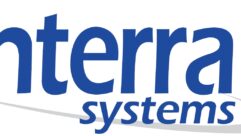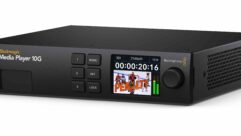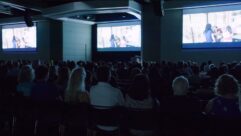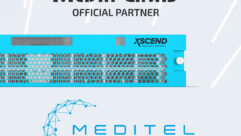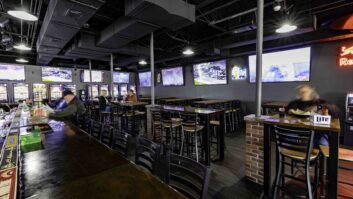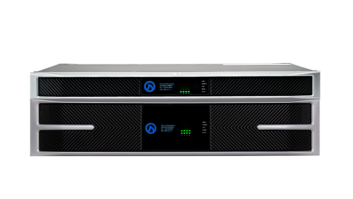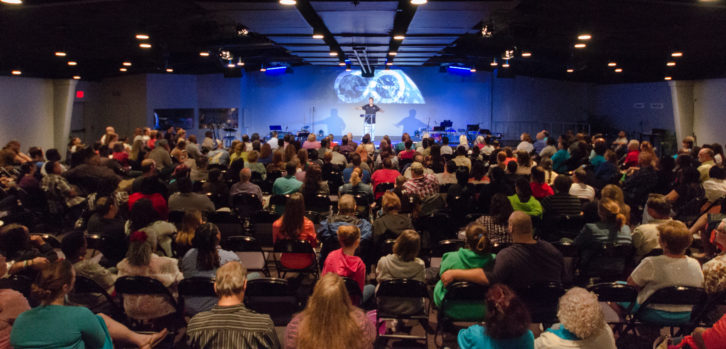
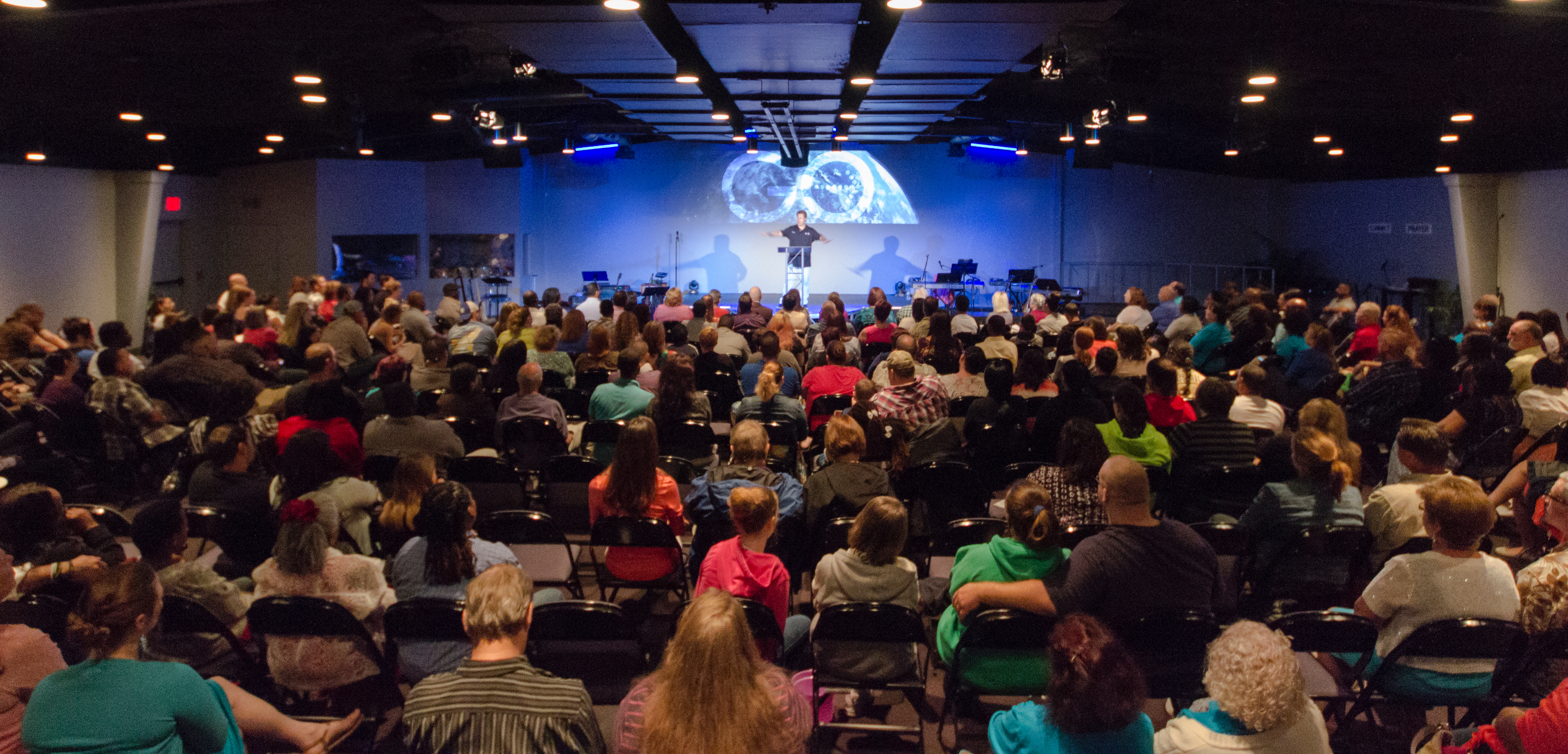
Small churches can now have a big media reach, and selecting the right production gear can make a huge difference in getting the word out. In Ocala, Florida the NOW Church does that with ATEM switchers and cameras from Blackmagic Design. Ricky Perinchief of Proton Global Media Group outfitted NOW Church with their system and he’s here to give us the story.
SVC: Tell us about Proton Global Media Group and yourself. You’ve had a lot of experience in the tech side of media production. Do you specialize in churches?
Ricky Perinchief: I do. I’m a pastor’s son so I started out early on. In fact, my father’s first job in ministry back in the ‘80s was at a local Christian television station in Orlando. So as a young kid—six, seven, eight years old—I was around the control room. I was around cameras. Then after my father became an associate pastor at a large church in Orlando and they were on national television, I would sit in the control room as my dad was working and just would watch them edit and watch them shoot and watch them produce and I always had a knack for that. Then my dad then planted his own church, NOW Church, here in Ocala, Florida, in 1990. So growing up I was trying to find my own way in church and was able to get into the technology side at a young age; first in audio and then into video. Twenty years ago, I started the church’s television ministry and it’s grown by leaps and bounds. Of course I’ve seen a lot of technology changes. So now with Proton Global I’ve been able to take all my production background from working with Disney, Universal, Governor Jeb Bush, Showtime, Universal Pictures, all these different things in my production career, and I’ve taken that knowledge of broadcasting into church life to help them do something affordably and systematically. So that’s kind of what we do with Proton Global.
You told us a little about the NOW Church. What kind of worship style do they have? How have they used AV technology?
NOW Church has always been really technologically advanced. My father was a youth pastor first and he grew up in church as a teenager because his parents dragged him there. It wasn’t until he was a late teenager or early 20s, that he actually found God and found Christianity. And he did that by connecting to a church that was more nontraditional. I think that upbringing caused him to birth NOW Church where it’s something that’s very nontraditional. It’s really geared towards the young and the young at heart. Being in Ocala, we’re actually about 30 minutes away from The Villages, which is one of the largest retirement communities in the country; one of the fastest-growing. We have so many people come in from The Villages and they love our contemporary worship style. They love being around the young and the young at heart. And also I think we’re a very multicultural church. Back in 1990 when we first began, we started getting people of color coming in. There was a lot of pressure back in that time, even in Ocala, to be more segregated as far as churches go, so really I think we pioneered being able to have a multicultural, multigenerational church. And that’s something we really pride ourselves in. We’re not a black church. We’re not a white church. We’re not a Hispanic church. We’re not an Asian church. We have so many people of different backgrounds and different ethnicities, which make our church who we are, and bring a lot of those influences into our worship experiences.

We know that you’re on social media, but as far as the TV coverage goes, how does NOW Church get their signal out to a global audience?
We started out on the local ABC affiliate here in the Ocala and Gainesville area and had a long relationship with them as well as Super Channel 55, which is a large Christian station based in Orlando. Very big signal that eventually grew into satellite in Europe and different places. And then, of course, as broadcast kind of merged with the internet and Apple TV and podcasting and everything, we’ve really grown and adapted and have been able to get our services out online as well, and have that social media presence, which I think has really been interesting. Especially being in this industry 20 years. I remember going to NAB even 20 years ago where they were saying television and internet will be merging. You hear that there’s not going to be just an animal channel. There will not be just a dog channel. There will be specific content, like even a golden retriever channel. And 20 years ago we really didn’t know what that looked like. I think now we’re seeing where YouTube has gone, where the internet has gone. With Apple TV and Amazon and Hulu and Netflix, you’re able to see that, absolutely, there’s room for everybody and there are ways you can distribute the content wherever people are. They can get it on demand, they can get it live, and you can reach different groups a lot easier than you could and a lot cheaper than you could back when just television and radio were just the alternative. So it’s been an exciting transition.
Blackmagic Design has been central for you and you recently added an URSA Broadcast Professional video camera. That’s a pretty advanced piece of equipment. You have a volunteer tech crew. So what’s the learning curve on that thing?
Well, you know, it’s not too bad, especially because of the Blackmagic system. And really, we were early adaptors to all things Blackmagic. I kind of saw where they were headed, and of course even at NAB, in the last five years or so you’ve seen them really take over the helm and you see all these huge banners and all this advertising and this huge booth and the huge buzz that they’ve created. I think they’re bringing a group of products and just great research and development to be able to find out what clients are wanting, what customers are requesting and needing, and being able to meet that in a budget-friendly way. And especially for churches, most of us do run on a heavy volunteer presence. We can’t do what we do without volunteers and we want to make sure our technology can really make them shine and can really be easy for them to learn and use. I think Blackmagic’s whole system, the way they’ve developed the ATEM switcher and the cameras and the way the camera control can be, and the template-driven approach, it’s very easy for volunteers to open up the template and operate this stuff. So somebody like me will come in and design a system and integrate and make sure everything is talking to each other and everything is set up the way it needs to be. And then the volunteers are able to just open up the templates and run with it—it’s just super easy and super user-friendly, which I think is why Blackmagic has grown in leaps and bounds. Specifically on the URSA Broadcast, we started with the first Blackmagic cinema camera years back when it first came out. We preordered it at NAB, in fact, and of course waited, I think, a year or over a year for it. Once it finally came out we just loved it. It’s a product that is cost-effective. Then when we were looking to upgrade our studio cameras, that was right around the time that the Blackmagic HD studio camera was coming out. So we ended up getting one of those and we used it for quite a while. In fact, we just retired our last one just a few months ago before we got this URSA Broadcast. With the studio camera, the difference was it was not great in dynamic range. And of course, everybody and their mom asked me every week how do you get a B4 lens on the studio camera and how do you work with it in church? And really, that was a difficult question. I had people all over the world calling me, texting me, tweeting me, asking me. And I think Blackmagic heard those cries and with the URSA Broadcast they’ve really fixed a lot of the things that people are crying out for by releasing the first camera that is actual native B4 2/3-inch sensor that is not limited to just 1080p but can also do 4K. When those ultra HD lenses become more affordable and more the norm, we’ll be prepared for it, which is great. So I think with the URSA Broadcast, with the dynamic range, with the sensor, the clarity you can get, if that hasn’t caught your attention yet, I think it will.

And you also use the Micro Studio Camera 4Ks. How have you got those set up?
We have an URSA Mini Pro with the B4 adaptor, which is our Camera 1. Our URSA Broadcast is our Camera 2 and those are both on sticks. And then we also use the Micro Studio 4Ks just all around the room in different places, especially because we can control them with the ATEM switcher and the camera control from Blackmagic. We’re able to control the colors, the white balances—all of the settings just snap back as soon as you turn that computer on and load that ATEM template. One of those cameras is on a jib; one is on a wireless track camera. We actually invented the track, it’s kind of a remote-controlled car chassis, and it’s controlled by somebody in the back who has a remote-controlled car trigger and they’re just running that thing back and forth from the back of the room to the front of the room, kind of a bird’s-eye view of the worship experience. And then we also have one camera on a DJI Ronin M, which is the newer stabilizer, which is amazing—we have a wireless transmitter on that rig as well. So two of our cameras are wireless and then we have a couple more Micros around the room just in static positions with MFT lenses. What we’ve found in integrating the whole Blackmagic workspace with all the different cameras is we’ve been able to grow and expand in phases. So every time Blackmagic releases a new camera and a new update we might not be able to afford all of the cameras to be replaced at that point, but we can at least get a new one like we just did with the URSA Broadcast. We’ll get that guy in and we’ll allow him to be connected to the ATEM switcher and to the template and we can match to the other Blackmagic cameras that we already have. So we can add gear systematically and phase it in and not have to really adjust a lot of things. We can incrementally add. Which has been great because the URSA Broadcast just fit right in. Within a day of getting it we had it dialed in and matching the other cameras. That’s also true with the Micro Studio 4Ks. In that case the MFT lenses are not a parafocal lens, which is one of the issues that a lot of people complained about. The moment you zoom is the moment you have to focus, so they’re not really great for studio-type stuff. But around the room and on tracks or on a wireless gimbal or a wireless Steadicam-type product, they look amazing and they really match well with the whole Blackmagic workflow.
And the expansion port on those, I guess that makes the camera control wiring somewhat easier.
Absolutely. I think some people complain about, “What is that cable for?” Well, I think a lot of Blackmagic’s philosophy—and even from spending some time with their founder— is that these little things really make the product sing. For somebody like me who integrates, we appreciate the little things, like being able to talk to the different cameras, being able to have the open source where we can control things via even a software like QLAB. So for example that supports situations where we can have the clients control their cameras, control their switchers and video hubs via QLAB with time of day triggers. Having that open source from Blackmagic gives us the ability to program that type of stuff.
So for small churches the Blackmagic gear sort of takes the functionality of an aircraft carrier and puts it all in a rowboat.
There you go. That’s exactly right. That’s a great analogy.

So let’s get into the wireless video transmitters, the camera switching, recording and your playback devices. There are some wireless video transmitters that you use to get the video from the cameras back to the switcher.
That’s right. We have a Teradek Bolt that we use for our wireless DGI Ronin gimbal and then we also have a Paralinx Ace that we use for the track camera that brings the signal wirelessly. Both of those are via SDI.
I’m sure that comes in very handy in allowing the people and the gear to move around more freely and better suit their more mobile style.
Absolutely. You know, I think especially with the DGI Ronin and the track both being wireless it gives us that broadcast look that I think is maybe missing in some churches. Because I think the downside to Facebook Live and having churches be able to broadcast their services very easily is a lot of them might not think of the broadcast style and how to keep people interested and how to utilize some broadcast angles and tips and tricks to make things look excellent. We use those angles and tricks, and also the DGI Ronin gives us that Steadicam type of look that you see on The Voice and American Idol.
Now you have more than just the Sunday services going on there. Sometimes the control room doubles as a recording studio. So you’ve got to be able to pick up everything and move it around.
We do, which is another great thing for the Blackmagic ecosystem. The ATEM 1 M/E Advanced Panel has been something that’s been awesome because it’s a PoE device. We have the racks on one side of the building in like an electromechanical room, and then we run one Ethernet cable that goes to our control room and that literally just powers that Advanced Panel switcher. We’ve been able to basically control everything from there even though it’s quite far away from the rack. It keeps the control room quiet and not as hot as most control rooms are. The other thing is we were very stretched for space; we really utilize every square inch we have. The control room is a very small space and in order to pull off what we do during the week, it’s actually our recording studio for ProTools. Our worship pastor is in there and our engineers are in there mixing things and writing music and laying out different tracks and stuff. And so we unplug that advance panel— all we do is unplug that one Ethernet cable, and then just stick it in a cabinet for the rest of the week until Sunday comes along and we need to bring it out. With the URSA Broadcast and the URSA Mini Pro, on Sundays they’re our studio cameras, but then during the week we can take them out and shoot commercials or interviews or openers or music videos. We can basically produce that content via the same cameras and the same equipment because they all work outside the studio as well, just with different adapters. Of course with the URSA Mini Pro, we have the EF adaptor and we can stick our nice EF Cine lenses on there. And then with our B4 stuff it looks great even in outdoor lighting as well, with the ND filters it has.

You’ve also got a number of places you have to route the live video to and for that I think you were using the Smart Videohub 20×20.
That’s right. So the Blackmagic cameras, of course, all require a return feed, so all of our return feeds come from that Smart Videohub. And then the rest of those outputs actually go around to the campus, so they deliver video to the pastor’s study, to the sound booth television monitor, the nursery, the lobby, all those different places where we have the signals. We just use SDI wiring from that Videohub and drop it right at the television end point and then we just use the new Blackmagic SDI to HDMI micro converters. So I think for 40 bucks or so we can get that signal back down to HDMI and really have everything controlled via the Videohub’s iOS app or even the Mac app that we use.
I’m sure with your experience you’re as aware as anybody that probably the majority of smaller churches are what I would refer to as “lighting challenged”.
[Chuckles] You’ve got that right.
So what advantage does the URSA Broadcast Professional camera give you in that kind of situation?
Well, I think they learn at Blackmagic. The dynamic range on the studio camera wasn’t ideal. So any church who tried to just stick that in their normal workflow and not have the proper lighting would have to gain that camera up and it would be very difficult to get a clear image without having grain and noise introduced. With the URSA Broadcast, even most B4 lenses will go down to F1.7 or so. You can literally open up those irises wide. And you won’t have any softness on the edges because the sensor is a native 2/3-inch B4 sensor. So there’s no softness, no vignetting, as some of the adaptors to the studio cameras had. But then also it looks fantastic in low light because the dynamic range is closer to that of the URSA Mini Pro, which of course is a camera that is quite a bit more expensive than the URSA Broadcast. So what they’ve done is really allowed churches who don’t have maybe adequate broadcast-style lighting open up their iris wide, have full range of that zoom, and be able to film the pastor, film the stage and get all the different shots that they need to around the room. And not be relying on perfect lighting.
Maybe one of the big challenges is running the iris wide open in low light and having the volunteer camera crew trying to hold focus for IMAG.
Absolutely. IMAG is a big issue. But the ATEM template is loading all the features, it’s loading the white balances, it’s loading all the colors. All the different functions of the camera are being recalled and are basically overriding the manual controls. So that way the volunteer can literally just learn the basics and really focus on: “what’s the proper image?” “What’s the rule of thirds?” Even taking some of those photography-style classes to just learn the basics and just know what looks good. So they can really focus on what they’re doing and what the image looks like and really not have to worry about the technical side. An integrator or maybe one of the staff members who has more experience can come in and set that stuff up and then just save it to the template.

You have the live video and sound coming in, so what do you use for recording and playback?
We use the HyperDecks as well because we, of course, stick with the Blackmagic ecosystem. HyperDecks was a great product introduced years back that now over recent years and recent upgrades they have integrated well with the ATEM switcher and the software. So we can actually control the HyperDecks right from the panel, right from the software. We can record, we can play back, we can have multiple HyperDecks and they’re all timecoded and they all talk to each other. You don’t have to leave that control room seat and you can sit there and be confident and see the timecode running, see the record light going on the software, and make sure those HyperDecks are going. You can feel confident to know that not only are you doing what you should be doing live, but it’s being recorded properly. Even the new HyperDeck Studio Mini has been really a very cost-effective product that relies on SD cards and SD media. You can really fit a lot of stuff on there, especially even ProRes and ProRes 422 and 422LT. ProRes 422LT is our go to for churches at this point because it’s great resolution and it looks good, and it’s compressed in a decent way where it’s not going to take up a huge amount of space. So yeah, we really rely on those HyperDecks heavily and not only for us to record our program output, but also to record a clean feed version as well. We can go back and gather B roll and gather things for commercials and marketing. We can pull some cool highlights of the day and we can log those into B roll. And then the entire master is basically wiped out and reused.
How does the tech crew communicate during the services?
We use Unity Intercom. So Unity is a product that definitely, over the past couple of years, has grown quite a bit and has gone to different aspects of broadcast with the ESPN X Games and the Olympics. It brings affordable wireless communication to churches and to other genres. Unity is a Macbased application and server software based off licenses; it uses iOS devices or Android devices. So our team of volunteers, most of them have either an iPhone or an Android so when they come in they just have the software of the Unity app installed on their phone and they can basically connect to our Wi-Fi that we have set up for Unity. They can communicate wirelessly on six different channels. So you can have lighting on one channel. You can have broadcast on another. The parking lot crew or the ushers, the security team might be using some of the other channels of Unity. So really it’s something where it brings affordable wireless communication—even having the ability to have the program monitor and program output so you can hear what’s going on in the service as well. So even if you’re out of the room or maybe you’re at another campus, you can communicate on a cellular network. It’s really cool the way that Unity works.
Looks like you have a good setup for what you’re doing now. So what’s next? What kind of tech upgrades do you have planned going on after this?
Well, I think for us, you know, we just recently installed the URSA Broadcast. We have the ATEM 1 M/E, and then we also have the new ATEM 4 M/E switcher. So those were really big video upgrades for us. But we really just try to see what comes up in technology and try to integrate that as soon as we can and as cost-effectively as we can, and phase it in. Out goal is to phase out some of the older cameras that we have. I think the next one up for replacement is going to be the Micro Studio 4K that we have on the jib. We’d love to make that an URSA Broadcast. With the Blackmagic workflow, every upgrade we get makes it easier and easier for us to just integrate that one product and phase out another. So really, instead of a whole huge upgrade like some churches need to do, we’re able to upgrade as we can every few months or every year or every couple of years when we have the budget and when products are available for us to make the move. So for us, I think that where we’re headed as a church and also with a lot of our clientele in churches all around the country is to really provide a lot more automation. I think automation really is where things are going even more in the future than they are now.
OK, we’ve touched on this, but what do you consider to be the most important aspect to selecting and installing video and sound equipment so that it can easily be operated by volunteer tech crews?
Well, I think that we’ve got to make sure that the volunteers can be confident and feel like they’re accomplishing something. In years past maybe we’ve had to look for somebody who is a little more technical, especially in running cameras and running the switcher and things. And nowadays, gosh, even audio and lighting, there are so many options; you can go the gamut of technology. But now with the ability to save templates and to have stuff programmed and preprogrammed, I think a lot of it goes back to the fact that you can set up your volunteers to be confident in what they do. You’re not putting too much pressure on them to learn all this crazy stuff. A lot of them work full-time jobs and they’re in an industry, a lot of them, that’s totally unrelated to running camera or running sound or running lighting at a church. So they have their own stresses during the week. To have the ability to have everything preset and pre-done for them just makes it so much easier to say ‘all right, you don’t have to worry about a lot of these controls here. But here’s how you really produce a great image. Here’s what we’re looking for with the rule of thirds. Here’s a tight shot. Here’s a full-body shot. Here’s where your headroom is supposed to be. Here’s how you lead somebody. So I think that has really enabled volunteers to shine and to integrate more people and keep them happier.


